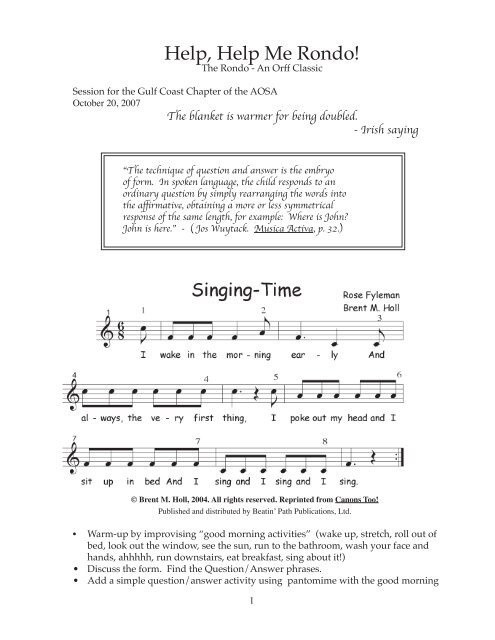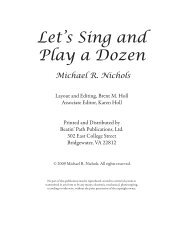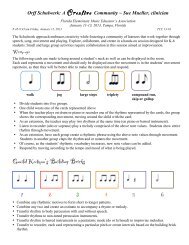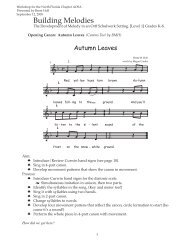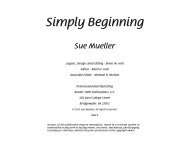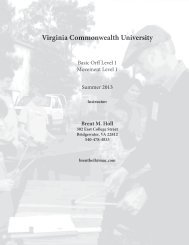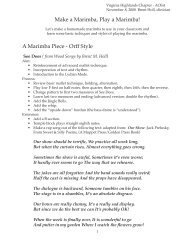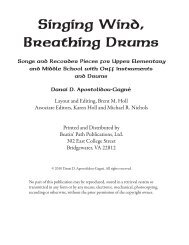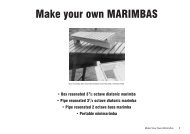The Rondo - Beatin' Path Publications, LLC
The Rondo - Beatin' Path Publications, LLC
The Rondo - Beatin' Path Publications, LLC
You also want an ePaper? Increase the reach of your titles
YUMPU automatically turns print PDFs into web optimized ePapers that Google loves.
Help, Help Me <strong>Rondo</strong>!<strong>The</strong> <strong>Rondo</strong> - An Orff ClassicSession for the Gulf Coast Chapter of the AOSAOctober 20, 2007<strong>The</strong> blanket is warmer for being doubled.- Irish saying“<strong>The</strong> technique of question and answer is the embryoof form. In spoken language, the child responds to anordinary question by simply rearranging the words intothe affirmative, obtaining a more or less symmetricalresponse of the same length, for example: Where is John?John is here.” - ( Jos Wuytack. Musica Activa, p. 32.)© Brent M. Holl, 2004. All rights reserved. Reprinted from Canons Too!Published and distributed by Beatin’ <strong>Path</strong> <strong>Publications</strong>, Ltd.• Warm-up by improvising “good morning activities” (wake up, stretch, roll out ofbed, look out the window, see the sun, run to the bathroom, wash your face and••hands, ahhhhh, run downstairs, eat breakfast, sing about it!)Discuss the form. Find the Question/Answer phrases.Add a simple question/answer activity using pantomime with the good morning1
movement. Teacher sings, class moves.• Learn the song from the overhead.• Try it out in 2, 4, and 8 part canon.Question - Answer for Body PercussionAim -review body percussion technique; rhythmic improvisation; phrase length.• Give the class a question using body percussion; all answer.• Make sure everyone ends at the strong beat of the last measure. “Final Point.”• Make sure the answers are not an exact imitation of the question.• Make sure the answers are related to the question.• Ask who wants to give the teacher a question?• All get a partner, question answer with each other.• Discover:• <strong>The</strong> cadence point (<strong>The</strong> Final Point) on the last strong beat of the answer.• <strong>The</strong> absence of a cadence point (Final Point) in the question (think CHA, CHA,CHA).• <strong>The</strong> commonality or shared ideas between the question and answer. <strong>The</strong> answershould have common elements with the question.• <strong>The</strong> question and answer phrases are the same length.Question - Answer for Unpitched PercussionAim - review of unpitched percussion technique; rhythmic improvisation appropriate totimbre; phrase length.• Using a tambourine, teacher asks a question to whole class.• Everyone takes a turn asking a question as a solo. If the player is a wood, all woodsanswer, metal, then metals, drums, then drums.Note: <strong>The</strong> teacher can improvise a piano accompaniment in free atonal style supporting thestudent questions and answers.Question - Answer for Pitched InstrumentsAim - review of pitched percussion technique; pentatonic improvisation appropriate totimbre; phrase length.• Teacher asks class a question on a pitched instrument in a pentatonic scale• NEW POINT: the answer MUST end on the tonic!• Establish a bordun + tone color.• Solo xylophone asks xylophones a question.• Solo metallophone asks metallophones a question.• Solo glockenspiel asks glockenspiels a question.• All think a question with inner ear, tutti answer.2
<strong>The</strong> <strong>Rondo</strong>“A musical form with a joyful refrain repeated at least threetimes with in-between contrasting couplets.” (Wuytack, ‘77)“<strong>The</strong> rondo form gives opportunities for creativity becausethe couplets are used for improvisation. <strong>The</strong> present rondoform is derived from the 12th century French rondeau. <strong>The</strong>rondeau is representative of the dancers performing in acircle formation and the couplet (dans par couple) meantthat one couple would improvise a dance.” (Wuytack ‘ 92)<strong>Rondo</strong> for Body Percussion
• Give the class a question using body percussion; all answer.• Make sure everyone ends at the strong beat of the last measure. “Final Point.”• Make sure the answers are not an exact imitation of the question.• Make sure the answers are related to the question.• Ask who wants to give the teacher a question?• All get a partner, question answer with each other.• Discover:• <strong>The</strong> cadence point (<strong>The</strong> Final Point) on the last strong beat of the answer.• <strong>The</strong> absence of a cadence point (Final Point) in the question (think CHA, CHA,CHA).• <strong>The</strong> commonality or shared ideas between the question and answer. <strong>The</strong> answershould have common elements with the question.• <strong>The</strong> question and answer phrases are the same length.• Play a <strong>Rondo</strong>!<strong>Rondo</strong> for Drums (Can be adapted for Unpitched Percussion)6/8 HeartbeatHi Drumw malletsAgogoCabasaShakereBass Drumw stick on side÷÷÷÷68686868œ œ œ œ œ ‰ œ œ œ œ œ ‰jœ . œ . œ œ œ .œ ‰ œ œ œ ‰ œ ‰ œ œ œ ‰œ . ŒJ œ œ . Œ.. œ Œ ‰œ . œ .œ ‰ œ œ œ ‰jœ œ œjœ œ œœ . Œ ‰œjœ œ.œ ‰ œ œ œ ‰jœ œ œarr. by BMHjœ œ œ....• Learn the drum parts, then add the Agogo and Cabasa.• Note the repeat. With a repeat it’s the same length as a Question/AnswerPhrase. Play a total of 4 times to complete the couplet. (8 beats of 6/8 = 4measures = Question or Answer phrase)••••Use this for your Refrain and create a <strong>Rondo</strong>.Find some different ways to play Questions and Answers using groups, individuals,or combinations of various kinds.Decide on a Form for your rondo.Play it!
<strong>Rondo</strong> for Pitched Percussion••••Learn this melody, or make up a new one as time allows. Make sure it follows thephrase length of a couplet in 4/4. (8 beats in 4/4 = 2 measures = Question or Answerphrase.Add the given ostinatos and bordun, or make new ones.Find some combinations of Timbres and decide on the Form for your <strong>Rondo</strong>.Put it together in a big performance.Question/Answer in Movement.Soldier’s Joy - from “Ensemble” by BMH.Aim:• Use traditional Folk Dance steps with the Q/A technique.• Transfer Q/A technique to movement.Process:• Formation: A Circle.• Make up a refrain of favorite Folk Dance circle dance moves done by the group thatcan be repeated for each A section.• Brainstorm some Partner moves for each in-between contrasting couplet that can bedone in the circle formation.5
A Jazz <strong>Rondo</strong>4& b& b c œ œSay hel -C7œ œ œ œ œ œ œ œoth-er Fri day morn ing what moreFœ œ œ œ œ œ œ œgm7œ œ œ œ œ œ œlo to the morn - ing, say hel - lo to the day, it's an -Fœ œ œ œcan I say?œ œ œPut aFœ œ œsmile on your face,œ œ œ œput the& b œ œ œ œ œ œ œ.œ œ œ œ œ œ œ œ œ œ œ œ œ Œ7gm7beat in your feet,A Good Morning SongMake ac7Fri-day morn-ing rhy-thm with some -Shirley McRae, arr. BMHfone you meet.Note to workshop participants:Please feel free to use anything in these notes written or arranged by BrentHoll for your own professional use in class or workshops. Simply make sure thatthe following notice is on each copy.© Brent M. Holl, 2007. All rights reserved. Used by permission.For all other materials permission must be obtained from the copyright holder.This workshop has been presented by:Brent M. Holl302 East College StreetBridgewater, Va. 22812540-478-4833brentholl@mac.com6


